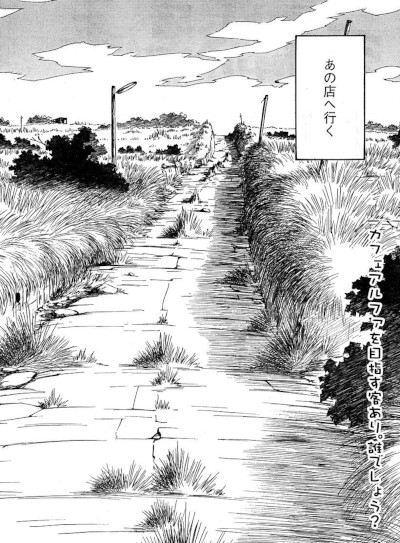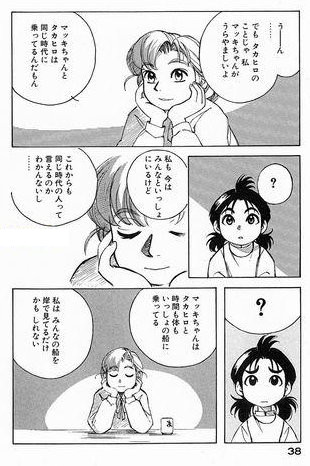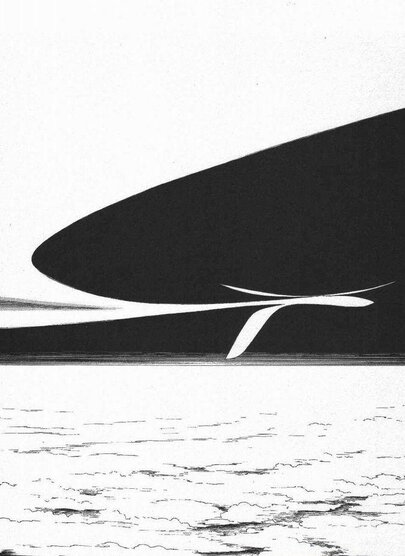Yokohama Kaidashi Kikou (ヨコハマ買い出し紀行, “Yokohama Shopping Trip Log”) is a manga by Hitoshi Ashinano serialised between 1994 and 2006. I wanted to write something after reading it, even though a lot has been written about it already, so I probably have no original insights to add. It is quite famous after all as one of the early examples of what is called “healing” post-apocalyptic stories (the Japanese term is iyashi-kei 癒やし系, iyashi means healing, comforting, offering solace).
In short, it is a series of related vignettes of the life of a robot called Alpha who looks like a young woman and runs a coffee shop in a remote rural area. It takes places after the ocean levels have risen so large areas of coastal land have been lost to flooding; the climate has changed for the worse, with frequent heavy rains in the coastal regions but much reduced rainfall further inland. This and other unspecified disasters have severely reduced the population. There are only a handful of characters, humans and very human-looking robots.
Why it is a good story to read now
I feel that this story has become more poignant and more relevant over time. When it was started, in 1994, climate change was to most people something abstract, and people like myself, who were aware and engaged, thought it might still be largely avoidable. Now we know that this is no longer the case, and the sea level rise pictured in the story is now entirely plausible. The change in climate in Japan will most likely be worse than the story imagines it.
Why I like it
For me personally there are many things to like in the story. I like Japan, and have fond memories of the Miura peninsula where the story takes place, and of Yokohama and Kamakura, even though I only visited those places briefly. I like the unexplained mysteries; and I like coffee. But none of that is required to enjoy the story. I like it that the story is on the whole not pessimistic, but does not ignore the bad things either, like the dwindling population and progressing coastal erosion.
I also like the drawings, in particular of the scenery. The way the characters are drawn is rather typically manga and although I don’t mind it, it’s not something that attracts me. The style does allow to portray the full range of expressions and emotions of the characters, so it works well. But the backgrounds and scenery are amazing and the pages and frames are very carefully composed as well.
The work is very lyrical, even poetic, in particular in the way the world is represented, and how the characters view it. It shows the beauty of the drowned landscapes and the roads and towns reclaimed by nature.

I find it notable that the depiction of beauty and the passing of time does not rely much (if at all) on the typical Japanese seasonal identifiers of cherry blossoms and autumn colours. It is very tempting to phrase the novel in those terms, in particular the mono no aware (物の哀れ, appreciation of the fleetingness of beauty). That is certainly an aspect, but is is much more about the quiet coming to terms with the twilight of humanity.
Robots that are forever young
Robots who are very much like people but don’t age is an interesting literary device. It reminds me of the Immortal in Xia Jia’s Eternal Summer Dream, of the tinkers in Ken MacLeod’s The Sky Road, and of Tolkien’s elves.
In episode #45, “Everyone’s boat” (みんなの船), Alpha explains it well to Mikka, one of the neighbourhood kids, even though the girl is a bit too young to understand it (Takahiro is a boy a few years older than Mikka, but also still a kid):
Makki: Do you like Takahiro? Takahiro likes you a lot, Alpha-san!
Alpha: Makki, you are very fond of Takahiro, aren’t you?
Makki: Well, yeah, I guess
Alpha: You know, I do like Takahiro
Alpha: Yes I do … But when it comes to Takahiro, I really envy you, Makki-chan
Alpha: Because you and Takahiro are part of the same age
Makki: ?
Alpha: Although I am now here together with everyone else
Alpha: … I don’t know if I can be considered a person of this same age from now onwards as well …
Makki: ?
Alpha: You and Takahiro are in the same boat, in time and body
Alpha: I guess I am just watching everyone’s boat from the shore
Alpha: Makki, you and Takahiro will always be together, right?
Alpha: That’s why I envy you

Coffee and the state of the world
The presence of coffee in the story gives important information about the world. In one scene late in the story (#138, “air”), a now adult Makki gives Alpha bags of Columbia, Kona and Formosa coffee beans. That means that in all those places (Columbia, Hawaii and Taiwan) coffee is still grown in sufficient quantities to be traded to Japan, and that overseas trade still exists and is still capable of transporting such goods. It also means that roasting coffee beans is still a profitable occupation. So, even though we can assume that the sea level rise is global and the population reduction probably as well, it means people are still sufficiently organised to realise such things. And as coffee is hardly essential, it is likely not the only good that is being produced and traded. In fact, although the world depicted in the story seems bucolic, there is quite a bit of technology in it that could not exists without a high level of societal organisation, like electrical scooters and vending machines for hot and cold drinks. Manufacturing such machines requires a complex supply chain, and also a sufficient number of customers to make it worthwhile. So although humanity has been reduced in size, it does not seem to have been reduced much in terms of its capabilities.
The Taapon and the other Alpha

There is a particular aspect of the story that I find fascinating. Interspersed throughout the story are scenes of another Alpha in what looks like a huge lab. The Alpha there is addressed as 室長 (“shitsuchō”, laboratory manager or section chief); I will call her Lab Chief Alpha to distinguish her from the protagonist Alpha.
These scenes are set inside the Taapon, a huge, very high flying plane. The title of the story (#20) where it is introduced is in Japanese “鵬(HOH)” (the kanji is uncommon, so the text gives its reading, “hoh” or “hō”). The meaning of this kanji is the Chinese word “Da Peng”, which in Japanese is rendered as “Taapon” (ターポン). In Chinese mythology, the Da Peng (大鳥, “large bird”) is a gigantic bird said to transform from a giant fish called K’un (鯤; Kon in Japanese). The oldest occurrence of this myth is in the Zhuangzi (荘子), an ancient Chinese text dating from ca 300 BCE, one of the foundational texts of Taoism. Part of this myth reads:
In the northern darkness there is a fish and his name is K’un. The K’un is so huge I don’t know how many thousand li he measures. He changes and becomes a bird whose name is P’eng. The back of the P’eng measures I don’t know how many thousand li across and, when he rises up and flies off, his wings are like clouds all over the sky. When the sea begins to move, this bird sets off for the southern darkness, which is the Lake of Heaven.
There are many interpretations of this text, but in the context of the story, it is easy to see the parallel between this mythical bird which sets out “when the sea begins to move”, and travels high, far and long, and the Taapon aircraft.
The title of the chapter of the Zhuangzi in which the myth occurs is “Carefree Wandering” (逍遙遊; Xiāoyáo yóu); the term “wandering” (遊; yóu) is used throughout the Zhuangzi to describe how an enlightened person “wanders through all of creation, enjoying its delights without ever becoming attached to any one part of it”. I think this description fits Alpha well.
Another foundational text of Taoism is the “Tao Te Ching”; and one of the books on Alpha’s bedside table in story #3 is called “Taoてポン” (tao-te-pon), which seems to be a pun on Tao Te Ching and Taapon.
There are lots of parallels between the Alpha on the ground and the Alpha in the air: they both have a strong affinity with flying and swimming. In a way, I think one can almost argue that Lab Chief Alpha is the Taapon, at least she controls its flight. And the Taapon is both bird and fish; and the Alpha on the ground often either dreams of flying or projects a part of herself flying in the air, and to her it feels like swimming through water. Lab Chief Alpha remembers swimming once, when she was still “down there”, and also compares flying to swimming, or at least she imagines that swimming must be like flying.
There is also Café Alpha’s wethervane, shaped like a fish with a small propeller. It is shown countless times, from the first page of the first story to the very last page of the final story. That it combines the concepts of fish, air and aeroplane is no coincidence.
All this indicates that the author intended this connection between both Alphas, the Taapon and the mythical bird that is also a fish. Now, is not really important per se, but because it is an integral part of the atmosphere of the story. Without the melancholy and mystery of the Taapon scenes, the story would lose a lot of its poetic appeal. The situation of Lab Chief Alpha, who is not quite unhappy but not happy either, and certainly not carefree and effectively locked in that huge plane, offers a counterpoint to Alpha who is much more happy, carefree and unconstrained. They both observe the twilight of the world but from very contrasting vantage points, Alpha immersed in it, Lab Chief Alpha detached from it.
I particularly like the final Taapon scene (#134, “radio”), which plays out while Alpha has fallen asleep under a parasol, to the sound of music from a portable radio.
Lab Chief Alpha says,
“Let’s plot yet another Northern course.”
“It’s getting quieter and quieter down there. Already, I don’t know how many towns and roads have disappeared.”
“But a little while after the lights of the people have gone out, blue lights tracing the towns and roads have appeared. At night, down there is once more shining with blue lights.”
“I wonder what they are all going through. “
“Wide lands have gone silent. The land where I was born is one of them.”
“But concentrated in smaller areas, there are still signs of humans.”
“From the island where I was born, the radio often plays carefree music.”
“The smell of rain, the smell of bonfires …“
“The smell of asphalt, the smell of fish, the smell of exhaust fumes …“
“Maybe, if once only the blue lights remain, it might be good for me to go there.”
“I don’t know if I want to or not.”
The author’s comment:
Whatever happens up in the air (Taapon) or on the ground, Alpha-san is what she is …
There is so much more in this wonderful story, please go and read it if you haven’t already.
The banner shows a digitally aged picture of the Yokohama skyline, before the floods (taken in 2015)
Further reading
- Report on a Shopping Trip to Yokohama – A Gentle End of the World, Doug Ikemi, 2007
- Review: A Healing, Gentle Apocalypse: Yokohama kaidashi kikō, Marc Hairston, 2008
- Understanding Disaster, Part 4: Yokohama Kaidashi Kikou and the Harmonious Apocalypse, Pause and Select, 2016
- ヨコハマ買い出し紀行 A Peaceful Future, 2017
